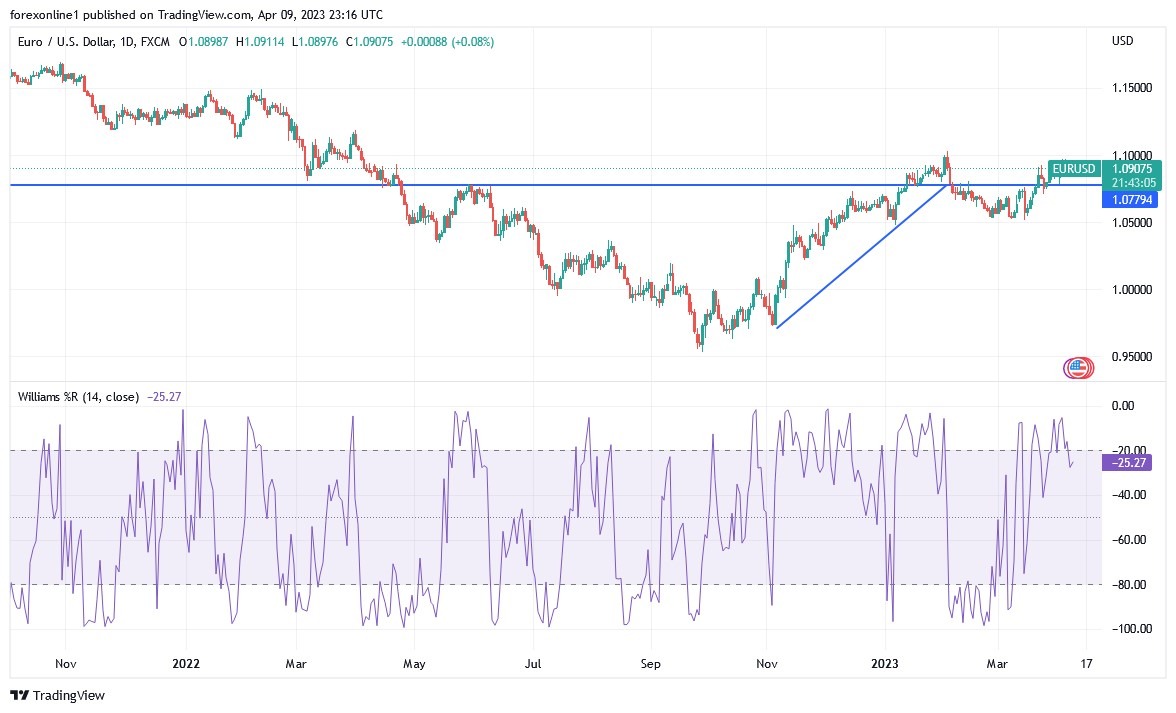EUR/USD Technical Analysis: New Important Trading Week
At the beginning of last week's trading, the EUR/USD exchange rate slowly made a strong comeback after moving below the parity rate in 2022. It traded at 1.0917 on Friday, which was 14.35% higher than the lowest point in 2022. It tested the level of support at 1.0875, after positive numbers for the US labor market, which supports the course of tightening the US Central Bank's policy, and closed trading stable around the level of 1.0898. The markets have been watching the US jobs numbers closely due to the current uncertainty about what the US Federal Reserve will do.
The Federal Reserve decided to raise US interest rates by 0.25% in March for the second month in a row. It also said it would continue to rely on the data in the coming months. When the Fed talks about relying on data, the two tasks are jobs and inflation because they are part of the dual mandate. Therefore, Friday's NFP data numbers were important as they will create a theme for what to expect when the Fed meets in May this year. According to last Friday's report, the US economy added a total of 236,000 strong jobs in March, indicating that the US economy remains on a solid footing despite the nine interest rate hikes imposed by the Federal Reserve over the past year in its effort to tame inflation.
According to official figures, the country's unemployment rate fell to 3.5%, just above its 53-year low of 3.4% in January. Meanwhile, some details of Friday's report from the Labor Department raised the possibility that inflationary pressures may be easing and that the Federal Reserve may soon decide to halt its interest rate increases. Average hourly earnings increased 4.2% from the previous 12 months, down sharply from a 4.6% year-over-year increase in February.
Ahead of the US jobs report
Data published last week indicated a possible weakening of the labor market in March. This past Monday and Wednesday, data from ISM showed that the manufacturing and services PMI fell in March. Another report by ADP showed that the private sector added fewer than 150,000 jobs in March, down from the 268,000 it added in February. Therefore, the strong NFP data will prompt the Fed to maintain its hawkish tone which is what has already happened. Earlier this week, Loretta Mester of the Cleveland Federal Reserve said it supported several rallies.
Technical analysis of the EUR/USD pair:
- The daily chart shows that the EUR/USD exchange rate continued its bullish trend this week.
- This happened with the continuing hopes of Europe's economic rise.
- Therefore, the EUR/USD pair moved above all moving averages, and the main support level at 1.0783.
More importantly, the pair is approaching 1.1032. This is an important level because it is a sign of the double top pattern, with the neckline at 1.0515. Therefore, for the pair to continue rising, it must move above this level. Failure to do so will see the pair continue to drop to the neckline at 1.0515.
In the near term, and according to the performance on the hourly chart, it appears that the EUR/USD currency pair has completed a downside breach from forming an ascending channel. This indicates a significant change in market sentiment from bullish to bearish. Therefore, the bears will target extended declines at around 1.0906 or below the support at 1.0889. On the other hand, the bulls are looking to extend the current rise towards 1.0933 or higher to a resistance of 1.0948.
EUR/USD may continue to move in narrow ranges until the markets react to the announcement of US inflation and retail sales numbers, as well as the content of the minutes of the last meeting of the US Federal Reserve.
(Click on image to enlarge)

More By This Author:
GBP/USD Forex Signal: May Retest Last Week’s High Of 1.2530EUR/USD: Weekly Forecast For April 9-14
Weekly Forex Forecast – Nasdaq 100 Index, Bitcoin, GBP/USD, Gold, Silver
Disclosure: DailyForex will not be held liable for any loss or damage resulting from reliance on the information contained within this website including market news, analysis, trading signals ...
more


